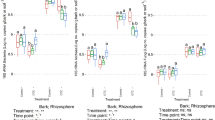Abstract
The bacterial isolates from normal and diseased branches of Kappaphycus alvarezii and Eucheuma denticulatum in the Philippines were examined for possible role in the development of the ice-ice disease. The numbers of bacteria on and in ice-iced branches were 10–100 times greater than those from normal, healthy ones. Gram-positive bacteria predominated in almost all branch sources, but with an increasing proportion of agar-lysing bacteria in branches suffering from the ice-ice disease. These agar-lysing bacteria were composed of yellow and non-pigmented, spreading colonies identified to the Cytophaga-Flavobacterium complex and the Vibrio group. Among isolates which mainly appeared on ice-iced branches, two strains, designated as P11 (Vibrio sp.) and P25 (Cytophage sp.), which showed pathogenic activity, were obtained. These strains caused early ice-ice whitening of K. alvarezii especially when subjecting branches to environmental stress, such as reduced salinity and light intensity, suggesting that these bacteria were occasionally pathogenic. This paper offers new evidence of bacterial role in the development of so-called ice-ice disease among farmed species of Kappaphycus.
Similar content being viewed by others
References
Andrews JH, Goff LJ (1984) Pathology. In Littler MM, Littler DS (eds), Handbook of Phycological Methods. Ecological Field Methods: Macroalgae. Cambridge University Press, Cambridge: 573–591.
Chan ECS, McManus EA (1969) Distribution, characterization and nutrition of marine microorganisms from the algae Polysiphonia lanosa and Ascophyllum nodosum. Can. J. Microbiol. 15: 409–420.
Collens J, Pedersen M (1992) Production of haloamine from Eucheuma species. In Mshigeni KE, Bolton JJ, Critchley AT, Kiangi G (eds), Proc. First Int. Workshop on Sustainable Seaweed Resource Development in Sub-Saharan Africa. Univ. Namibia Press: 69–75.
Fishery Statistics Bulletin (1992) Bureau of Agricultural Statistics, Department of Agriculture, Republic of the Philippines, 17 pp.
Fukami K, Yuzawa A, Nishijima T, Hata Y (1992) Isolation and properties of a bacterium inhibiting the growth of Gymnodinium nagasakiense. Nippon Suisan Gakk. 58: 1073–1077.
Holt JG, Krieg NR, Sneath PHA, Staley JT, Williams ST (1994) Bergey's Manual of Determinative Bacteriology, 9th edn. Williams & Wilkins, Baltimore, 787 pp.
Knutsen SH (1991) Large scale production of bacterial enzymes for depolymerization of matrix polysaccharides in seaweeds. In Reina GG, Pedersen M (eds), Seaweek Cellular Biotechnology, Physiology and Intensive Cultivation, Proc. COST-48 (Subgroup 1) Workship, Univ. Las Palmas, Canary Island, Spain: 277–281.
Kusuda R, Kawai K, Salati F, Kawamura Y, Yamashita Y (1992) Characteristics of Flavobacterium sp. causing ‘suminori’ disease in cultivated Porphyra. Suisanzoshoku 40: 457–461.
Largo DB, Fukami K, Nishijima T & Ohno M (1995) Laboratory-induced development of the ice-ice disease of the farmed red algae Kappaphycus alvarezii and Eucheuma denticulatum (Solieriaceae, Gigartinales, Rhodophyta). J. Appl. Phycol. 7: 539–543.
Linley EAS, Newell RC, Bosma SA (1981) Heterotrophic utilization of mucilage released during fragmentation of kelp (Ecklonia maxima and Laminaria pallida). I. Development of microbial community associated with the degration of kelp mucilage. Mar. Ecol. Prog. Ser. 4: 31–41.
Nair S, Simidu U (1987) Distribution and significance of heterotrophic bacteria with antibacterial activity. Appl. envir. Microbiol. 53: 2957–2962.
Oppenheimer CH, ZoBEII CE (1952) The growth and viability of sixty-three species of marine bacteria as influenced by hydrostatic pressure. J. mar. Res. 11: 10–18.
Quatrano RS, Calwell BA (1978) Isolation of a unique marine bacterium capable of growth on a wide variety of polysaccharides from macroalgae. Appl. envir. Microbiol. 36: 979–981.
Ramaiah N, Chandramohan D (1992) Densities, cellulases, alginate and pectin lyases of luminous and other heterotrophic bacteria associated with marine algae. Aquat. Bot. 44: 71–81.
Sarwar G, Sakata T, Kakimoto D (1983) Isolation and characterization of carrageenan decomposing bacteria from marine environment. J. gen. Microbiol. 29: 145–155.
Sieburth JM (1969b) Studies on algal substances in the sea. III. The production of extracellular organic matter by littoral marine algae. J. exp. mar. Biol. Ecol. 3: 290–309.
Shiba T, Taga N (1980) Heterotrophic bacteria attached to seaweeds. J. exp. mar. Biol. Ecol. 47: 251–258.
Shiba T, Taga N (1981) Effects of the extracellular products of Enteromorpha linza on its epiphytic bacteria. Bull. Jap. Soc. Sci. Fish. 47: 1193–1197.
Simidu U (1985) In Kadota H, Taga N (eds), Methods in Marine Microbiology: 228–233 (in Japanese).
Tsukidate J (1983) On the systematic relationship between Porphyra species and attached bacteria and bacterial pathogen in white rot. Bull. Nansei Reg. Fish. Res. Lab. 15: 29–96.
Uyenco FR, Saniel LS, Gomez ED (1977) Microbiology of diseased Eucheuma striatum Schmitz (Abstract only). J. Phycol. 13: 70.
Uyenco FR, Saniel LS, Jacinto GS (1981) The ice-ice problem in seaweed farming. In Levring T (ed.), Proc. Tenth Inter. Seaweed Symp. Walter de Gruyter & Co., Berlin: 625–630.
Weinberger F, Friedlander M, Gunkel W (1994) A bacterial facultative parasite of Gracilaria conferta. Dis. aquat. Org. 18: 135–141.
Yumoto I, Ezura Y, Kimura T (1989a) Distribution of the Alteromonas sp., the causative agent of red-spots on the culture bed of makombu Laminaria japonica. Nippon Suisan Gakk. 55: 453–462.
Yumoto I, Yamaguchi K, Yamada K, Ezura Y, Kimura T (1989b) Relationship between bacterial flora and occurrence of the Alteromonas sp., the causative agent of red-spots on the culture bed of makonbu Laminaria japonica, in the coastal area of Funka Bay. Nippon Suisan Gakk. 55: 1907–1914.
Author information
Authors and Affiliations
Rights and permissions
About this article
Cite this article
Largo, D.B., Fukami, K. & Nishijima, T. Occasional pathogenic bacteria promoting ice-ice disease in the carrageenan-producing red algae Kappaphycus alvarezii and Eucheuma denticulatum (Solieriaceae, Gigartinales, Rhodophyta). J Appl Phycol 7, 545–554 (1995). https://doi.org/10.1007/BF00003941
Received:
Revised:
Accepted:
Issue Date:
DOI: https://doi.org/10.1007/BF00003941




